
|
Great outburst occured on Oct. 24, 2007, and it bacame a naked eye comet of 2 mag. It kept so bright as 5.5 mag still on Apr. 30 (Carlos Labordena), but it was extremely faint and difficult to see. The size was so large, the diameter was larger than 60 arcmin. Now appearing in the morning sky, but still low. It will become observable in good condition in autumn again. The extremely faint large diffuse object may be detected with a best sky condition, around 5-6 mag with a diameter of 1 or 2 degrees.
Date(TT) R.A. (2000) Decl. Delta r Elong. m1 Best Time(A, h)
Aug. 30 8 22.63 28 60.0 4.485 3.726 36 6.1 4:57 (237, -4)
Sept. 6 8 30.55 28 31.6 4.447 3.753 41 6.1 4:48 (236, -2)
|
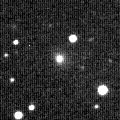
|
Now it is 6.4 mag (Sept. 5, Marco Goiato). Now it is brightest, and it keeps 6.5 mag until early October. In the Northern Hemisphere, it is not observable now. It will appear in the evening sky at 7 mag in ealy October, but it keeps locating in the evening low sky until the end of 2008 when it fades out down to 10 mag. Then it turns to appear in the morning sky, and it keeps observable in the northern sky after that while fading gradually. In the Southern Hemisphere, it is only observable until late October.
Date(TT) R.A. (2000) Decl. Delta r Elong. m1 Best Time(A, h)
Aug. 30 12 10.82 -45 40.9 1.331 1.182 58 6.8 19:03 ( 53, 30)
Sept. 6 13 3.37 -42 34.1 1.326 1.139 56 6.7 19:08 ( 58, 32)
|
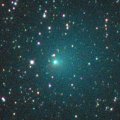
|
Now it is 8.5 mag (Sept. 5, Marco Goiato). Now it is brightest, expanding the large coma. It keeps bright as 9 ma until late October. In the Northern Hemisphere, it becomes low in the south at brightest, but it keeps observable until it fades out.
Date(TT) R.A. (2000) Decl. Delta r Elong. m1 Best Time(A, h)
Aug. 30 20 46.69 -29 45.8 0.401 1.365 147 8.8 22:12 (180, 85)
Sept. 6 21 3.74 -33 48.0 0.437 1.377 141 8.6 22:01 (180, 89)
|
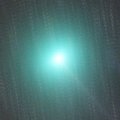
|
It became so bright as 4.7 mag, and so large as 20 arcmin in June (June 12, Marco Goiato). Now it is fading. But it is still bright as 9.8 mag (Sept. 3, Marco Goiato). It keeps observable in good condition for a long time after this. It will be visible visually until around November.
Date(TT) R.A. (2000) Decl. Delta r Elong. m1 Best Time(A, h)
Aug. 30 2 11.84 23 23.7 0.659 1.440 117 9.5 3:39 (180, 32)
Sept. 6 1 58.60 23 48.3 0.697 1.532 126 9.9 2:58 (180, 31)
|
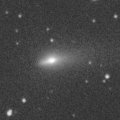
|
Now it is so bright as 9.3 mag (Aug. 28, Juan Jose Gonzalez). The condition in this apparition is bad. In the Southern Hemisphere, it keeps extremely low, or under the horizon, so it will not be observable. In the Northern Hemisphere, it is finally appearing in the morning sky. It keeps observable and fading in the morning sky after this. Now it is brighter than originally expected.
Date(TT) R.A. (2000) Decl. Delta r Elong. m1 Best Time(A, h)
Aug. 30 8 19.67 27 30.9 2.101 1.427 36 10.7 4:57 (238, -2)
Sept. 6 8 44.03 27 55.9 2.098 1.454 38 10.9 4:48 (238, -4)
|
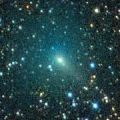
|
Now it is so bright as 10.2 mag (Aug. 28, Juan Jose Gonzalez). In the Northern Hemisphere, it keeps observable until 2009 spring when the comet becomes faint. It will move near by the Northern Pole from summer to autumn, and will be observable all night. It is about to start fading now, but it will be visible visually until around October. In the Southern Hemisphere, it will never be observable again.
Date(TT) R.A. (2000) Decl. Delta r Elong. m1 Best Time(A, h)
Aug. 30 13 55.46 86 56.5 1.732 1.832 79 11.3 19:03 (177,-33)
Sept. 6 13 12.65 85 51.7 1.750 1.864 80 11.5 19:08 (175,-34)
|
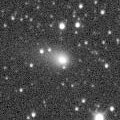
|
Now it is 10.8 mag (Aug. 30, Alexandre Amorim). Very small, and strongly condensed. It is expected to reach to 6 mag in 2009 February. It keeps observable until October. It will be unobservable temporarily in November, but it will appear in the morning sky again at 9 mag in late December.
Date(TT) R.A. (2000) Decl. Delta r Elong. m1 Best Time(A, h)
Aug. 30 17 30.23 -21 39.5 1.787 2.284 106 11.3 19:03 (170, 76)
Sept. 6 17 12.80 -21 28.1 1.872 2.207 95 11.3 19:08 (132, 71)
|
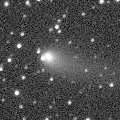
|
Now it is bright as 10.3 mag (Aug. 28, Juan Jose Gonzalez). It keeps observable in good conditioni as bright as 11 mag from autumn to winter. It keeps observable, visible visually, brighter than 14 mag for a long time until 2009 May.
Date(TT) R.A. (2000) Decl. Delta r Elong. m1 Best Time(A, h)
Aug. 30 4 38.89 53 42.7 2.362 2.438 82 11.5 4:57 (190, 0)
Sept. 6 4 56.64 54 56.3 2.301 2.434 85 11.4 4:48 (190, -1)
|
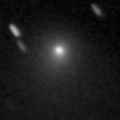
|
It reached to 10.9 mag in May (May 11, Marco Goiato). Now it is fading slowly. It has faded down to 12.0 mag on July 21 (Alexandre Amorim). Not observable in the Northern Hemisphere. It will be unobservable soon also in the Southern Hemisphere. In the Northern Hemisphere, it will appear in the morning sky again at 13 mag at the end of 2008, then it keeps bright and observable for a while.
Date(TT) R.A. (2000) Decl. Delta r Elong. m1 Best Time(A, h)
Aug. 30 12 35.56 -2 46.6 3.626 2.826 32 12.1 19:03 ( 96, 13)
Sept. 6 12 46.69 -2 31.4 3.691 2.842 28 12.2 19:08 ( 93, 9)
|
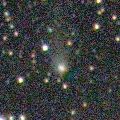
|
Now it is bright as 11.5 mag (Aug. 4, Marco Goiato). It keeps bright at 12 mag for a long time from 2008 spring to 2009 spring. However, it moves southwards, and it will be unobservable soon in the Northern Hemisphere. It will appear in the northern sky again in 2009 autumn, but it will be fainter than 15 mag and will keep locating very low after that. In the Southern Hemisphere, it keeps observable for a long time until it fades out, although it becomes low in autumn.
Date(TT) R.A. (2000) Decl. Delta r Elong. m1 Best Time(A, h)
Aug. 30 15 17.26 -38 30.2 2.747 2.773 80 12.1 19:03 ( 72, 62)
Sept. 6 15 16.60 -39 43.9 2.837 2.752 74 12.2 19:08 ( 69, 55)
|
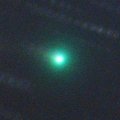
|
It brightened up to 9.2 mag on July 15 (Juan Jose Gonzalez). It is bright as 10.9 mag still on Aug. 9 (Juan Jose Gonzalez). Although it kept locating extremely low for a while in the Northern Hemisphere, it is getting higher gradually after this. It will be fading gradually after this, but it will be visible visually until September.
Date(TT) R.A. (2000) Decl. Delta r Elong. m1 Best Time(A, h)
Aug. 30 7 18.83 26 44.3 1.790 1.369 49 12.2 4:57 (229, 8)
Sept. 6 7 37.46 26 28.0 1.813 1.434 52 12.7 4:48 (229, 8)
|
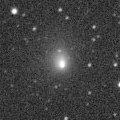
|
Brightening very rapidly, faster than expected. It is already so bright as 10.5 mag (Aug. 28, Juan Jose Gonzalez). It is expected to reach to 10 mag in 2009 summer. Because it moves in the northern sky, it keeps observable until it becomes brightest in the Northern Hemisphere.
Date(TT) R.A. (2000) Decl. Delta r Elong. m1 Best Time(A, h)
Aug. 30 3 48.51 71 7.0 4.249 4.284 85 12.9 4:57 (182,-16)
Sept. 6 3 33.85 72 40.5 4.118 4.241 90 12.7 4:34 (180,-18)
|

|
In the last season, it became so bright as 10 mag in 2008 January. Although it had been unobservable for a while, now it is appearing in the morning sky.
Date(TT) R.A. (2000) Decl. Delta r Elong. m1 Best Time(A, h)
Aug. 30 7 49.89 24 34.3 6.767 6.056 42 14.0 4:57 (236, 5)
Sept. 6 7 54.68 24 20.6 6.690 6.058 47 14.0 4:48 (234, 7)
|
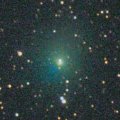
|
It reached up to 9.5 mag on Mar. 29 (Maik Meyer). Now it is fading slowly. It faded down to 10.7 mag on May 11 (Marco Goiato), and it was a diffuse object with a weak condensation. In the Northern Hemisphere, it will never be observable again. In the Southern Hemisphere, it keeps observable until it fades out. No observations have been reported recently, and the current brightness is uncertain.
Date(TT) R.A. (2000) Decl. Delta r Elong. m1 Best Time(A, h)
Aug. 30 10 40.03 -43 20.5 2.779 2.305 52 14.1 19:03 ( 46, 14)
Sept. 6 10 57.36 -45 47.4 2.861 2.380 52 14.3 4:48 (317, 14)
|
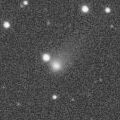
|
It brightened up to 12.7 mag in spring (Apr. 12, Marco Goiato). It will never be observable again in the Northern Hemisphere. In the Southern Hemisphere, it will be unobservable in October, but it will appear again in the morning sky at 15 mag in winter.
Date(TT) R.A. (2000) Decl. Delta r Elong. m1 Best Time(A, h)
Aug. 30 13 17.87 -19 45.8 3.532 2.976 49 14.2 19:03 ( 86, 31)
Sept. 6 13 27.82 -21 13.1 3.596 2.979 45 14.2 19:08 ( 82, 27)
|

|
It was 15 mag on Jan. 14 (Michael Mattiazzo), brightening as expected. It should have reached up to 13.5 mag in summer in the southern sky. Now it is fading. In the Southern Hemisphere, it keeps observable for a long time after this. But in the Northern Hemisphere, it is not observable now. But it will appear in the morning sky at 15 mag in November, then it keeps observable while the comet will be fading slowly.
Date(TT) R.A. (2000) Decl. Delta r Elong. m1 Best Time(A, h)
Aug. 30 10 2.32 -31 36.6 3.338 2.664 41 14.4 4:57 (300, 12)
Sept. 6 10 15.97 -31 13.0 3.397 2.691 39 14.5 4:48 (300, 13)
|

|
Now it is 15.1 mag (Aug. 1, John Drummond). It is not observable in the Northern Hemisphere now, but observable in good condition in the Southern Hemisphere. It is expected to brighten up to 10 mag from late 2009 to early 2010. Because the comet moves in the southern sky for a long time, it keeps impossible or very hard to observe in the Northern Hemisphere until 2009 September. But after 2009 October, it is observable at 10 mag for a while in good condition. In the Southern Hemisphere, it keeps observable for a long time while brightening until 2009 June when it brightens to 11 mag. But it becomes unobservable around and after the brightest time.
Date(TT) R.A. (2000) Decl. Delta r Elong. m1 Best Time(A, h)
Aug. 30 5 50.36 -41 21.6 4.804 4.771 82 14.5 4:57 (294, 62)
Sept. 6 5 56.44 -42 16.4 4.712 4.714 83 14.4 4:48 (296, 64)
|

|
Now it is 12.7 mag (Aug. 1, Juan Jose Gonzalez), bright and visible visually. It will be getting lower in the evening sky after this, and will be too low to observe in October. But it will locate high again in winter, and will be visible visually at 14 mag.
Date(TT) R.A. (2000) Decl. Delta r Elong. m1 Best Time(A, h)
Aug. 30 14 52.75 20 20.7 6.216 5.830 63 14.5 19:03 (138, 22)
Sept. 6 14 52.46 19 58.2 6.317 5.845 57 14.6 19:08 (131, 18)
|
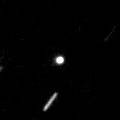
|
It had been so faint as 18 mag until July. However, an outburst occured on Aug. 3 and brightened up to 14.5 mag (Gustavo Muler). It is bright as 15.0 mag still on Aug. 29 (Gustavo Muler). However, it will fade out rapidly after this.
Date(TT) R.A. (2000) Decl. Delta r Elong. m1 Best Time(A, h)
Aug. 30 14 53.77 -2 28.5 3.611 3.324 65 14.8 19:03 (121, 40)
Sept. 6 15 0.24 -3 44.0 3.673 3.302 60 14.9 19:08 (114, 36)
|

|
It is expected to reach up to 7 mag in winter, and will be observable in good condition. However, this comet has not been observed since 1986. It is predicted to be brightening up to around 15 mag, bright enough to be recovered. However, it was not detected, fainter than 19.5 mag on Aug. 10 (Gustavo Muler), and fainter than 20 mag on Aug. 23 (Francois Kugel). It will brighten very rapidly near by the perihelion. The condition of this apparition is good. It keeps observable for a long time until 2009 early summer both in the Northern Hemisphere and Southern Hemisphere.
Date(TT) R.A. (2000) Decl. Delta r Elong. m1 Best Time(A, h)
Aug. 30 19 40.87 -25 14.5 0.971 1.835 135 15.5 21:04 (180, 80)
Sept. 6 19 35.71 -24 57.8 0.963 1.770 127 14.8 20:32 (180, 80)
|
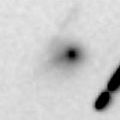
|
An outburst occured in late May, and it brightened up to 14.6 mag (May 23, Gustavo Muler). However, it faded down to the original brightness in late May. Now it is 17.0 mag (Aug. 3, W. Hasubick). It will reach to 14 mag in autumn, but it locates extremely low in the Northern Hemisphere. Some visual observers reported that it is visible and very bright. But actually, it seems to be much faitnter than this ephemeris now.
Date(TT) R.A. (2000) Decl. Delta r Elong. m1 Best Time(A, h)
Aug. 30 13 50.53 -1 53.3 1.690 1.298 50 15.2 19:03 (109, 28)
Sept. 6 14 10.40 -5 28.2 1.688 1.278 49 15.1 19:08 (103, 28)
|
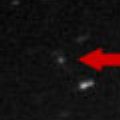
|
Now it is 16.2 mag (Aug. 3, Ken-ichi Kadota). It keeps observable while the comet will be brightening gradually after this. It will reach up to 14.5 mag in autumn. However, then it locates low in the evening sky, and it will be unobservable soon in December.
Date(TT) R.A. (2000) Decl. Delta r Elong. m1 Best Time(A, h)
Aug. 30 15 52.22 -8 24.8 2.198 2.271 81 15.4 19:03 (131, 54)
Sept. 6 16 0.95 -9 17.1 2.236 2.230 76 15.3 19:08 (123, 51)
|
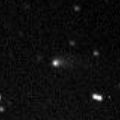
|
Now it is 15.6 mag (July 28, Ken-ichi Kadota). It locates somewhat low in the Northern Hemisphere, but it keeps observable around 16 mag until winter. It is also observed visually at 14.6 mag (Aug. 6, Juan Jose Gonzalez).
Date(TT) R.A. (2000) Decl. Delta r Elong. m1 Best Time(A, h)
Aug. 30 21 4.87 -29 5.2 2.013 2.937 150 15.6 22:28 (180, 84)
Sept. 6 21 0.66 -28 41.0 2.048 2.925 144 15.6 21:56 (180, 84)
|
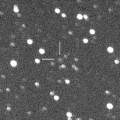
|
Now it is 15.5 mag (Aug. 21, Ken-ichi Kadota). It will be observable at 15.5 mag in good condition in next autumn. It will be visible visually.
Date(TT) R.A. (2000) Decl. Delta r Elong. m1 Best Time(A, h)
Aug. 30 3 56.92 23 0.2 3.093 3.336 94 15.8 4:57 (187, 32)
Sept. 6 3 47.76 23 22.1 2.955 3.341 103 15.7 4:47 (180, 32)
|
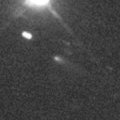
|
Now it is 15.2 mag (Aug. 2, Ken-ichi Kadota). Now it is brightest, and it will be fading after this. It keeps observable in good condition until it fades out in winter. The position is very different from the original prediction.
Date(TT) R.A. (2000) Decl. Delta r Elong. m1 Best Time(A, h)
Aug. 30 4 16.68 15 58.2 1.492 1.827 91 15.7 4:57 (194, 38)
Sept. 6 4 26.87 16 24.9 1.453 1.853 96 15.8 4:48 (191, 38)
|

|
It must have already brightened up to 16 mag. However, it was not detected, fainter than 18.5 mag on Aug. 2 (Giovanni Sostero and Ernesto Guido). It is expected to brighten rapidly after this and reach up to 10 mag in winter. However, it may be much fainter than expected in fact. It keeps observable in good condition for a long time until early summer in next year when the comet fades out.
Date(TT) R.A. (2000) Decl. Delta r Elong. m1 Best Time(A, h)
Aug. 30 2 51.37 20 35.6 1.572 2.143 110 16.3 4:18 (180, 34)
Sept. 6 2 59.32 21 11.8 1.457 2.094 115 15.8 3:58 (180, 34)
|
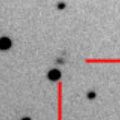
|
Not it is 16.0 mag (Aug. 30, J. A. Henriquez). It will be brightening gradually after this, and reach to 12-13 mag in 2009 winter and spring. In the Northern Hemisphere, it keeps observable for a long time until 2009 May.
Date(TT) R.A. (2000) Decl. Delta r Elong. m1 Best Time(A, h)
Aug. 30 21 6.02 -28 56.4 1.402 2.338 151 16.0 22:29 (180, 84)
Sept. 6 20 58.37 -29 12.4 1.395 2.285 143 15.9 21:54 (180, 84)
|
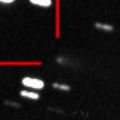
|
Now it is 16.2 mag (July 28, Ken-ichi Kadota). It will be observable at 16 mag in good condition in autumn.
Date(TT) R.A. (2000) Decl. Delta r Elong. m1 Best Time(A, h)
Aug. 30 3 11.97 12 35.8 1.568 2.109 107 16.3 4:38 (180, 42)
Sept. 6 3 19.27 12 32.0 1.501 2.108 112 16.2 4:18 (180, 42)
|
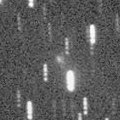
|
It was bright as 16.0 mag on June 30 (Michael Jager). Now it is 17.1 mag (Aug. 15, Ken-ichi Kadota). It keeps observable in good condition after this in the Northern Hemisphere. It will be fading gradually, and will be fainter than 18 mag in November.
Date(TT) R.A. (2000) Decl. Delta r Elong. m1 Best Time(A, h)
Aug. 30 22 44.46 57 21.8 2.036 2.610 113 16.7 0:12 (180, -2)
Sept. 6 22 33.77 58 3.1 2.070 2.661 115 16.8 23:28 (180, -3)
|

|
Appearing in the morning sky. It must be already bright as 17 mag. It will brighten rapidly after this. It will be observable at 12-13 mag for a long time from January to July in 2009.
Date(TT) R.A. (2000) Decl. Delta r Elong. m1 Best Time(A, h)
Aug. 30 7 54.64 23 47.8 3.704 3.014 40 16.9 4:57 (237, 4)
Sept. 6 8 5.38 23 21.2 3.612 2.988 45 16.7 4:48 (236, 6)
|
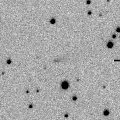
|
Now it is 17.5 mag (Aug. 31, Michael Jager). Recovered as bright as expected. It will getting higher, but will be fading gradually after this. It will be fainter than 18 mag in December.
Date(TT) R.A. (2000) Decl. Delta r Elong. m1 Best Time(A, h)
Aug. 30 7 35.69 25 17.4 1.882 1.376 45 16.8 4:57 (233, 7)
Sept. 6 7 59.91 24 40.3 1.878 1.396 46 16.8 4:48 (234, 6)
|
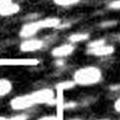
|
It was observed at 16.5-17 mag in 2007 autumn. Now it is 17.3 mag (July 2, J. F. Hernandez). It will be observable at 17 mag for a long time from summer to autumn.
Date(TT) R.A. (2000) Decl. Delta r Elong. m1 Best Time(A, h)
Aug. 30 4 44.60 27 28.4 2.457 2.550 83 17.1 4:57 (198, 25)
Sept. 6 4 51.99 27 45.1 2.395 2.578 88 17.1 4:48 (195, 26)
|
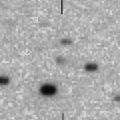
|
Now it is 16.4 mag (Aug. 31, J. A. Henriquez). It will be observable at 17 mag in good condition until November.
Date(TT) R.A. (2000) Decl. Delta r Elong. m1 Best Time(A, h)
Aug. 30 1 0.75 29 58.8 1.562 2.319 127 17.1 2:27 (180, 25)
Sept. 6 1 1.93 29 22.1 1.509 2.323 133 17.1 2:01 (180, 26)
|

|
Now it is 17.8 mag (Aug. 3, Ken-ichi Kadota). It will brighten up to 12 mag in 2012. It is faint still in 2008, but observable at 17 mag in good condition.
Date(TT) R.A. (2000) Decl. Delta r Elong. m1 Best Time(A, h)
Aug. 30 23 12.56 7 24.1 9.576 10.536 161 17.1 0:40 (180, 48)
Sept. 6 23 9.06 7 5.9 9.517 10.499 166 17.1 0:09 (180, 48)
|

|
It was observed at 17.5-18 mag in 2006 and 2007. In 20080, it will be observable at 17.5-18 mag from summer to autumn.
Date(TT) R.A. (2000) Decl. Delta r Elong. m1 Best Time(A, h)
Aug. 30 22 40.41 -23 33.9 3.172 4.157 165 17.3 0:08 (180, 78)
Sept. 6 22 36.59 -24 13.8 3.192 4.160 161 17.3 23:32 (180, 79)
|
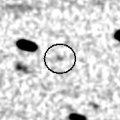
|
Now it is 18.2 mag (July 2, J. M. Ruiz M.). It will be observable at 16 mag in good condition from autumn to winter.
Date(TT) R.A. (2000) Decl. Delta r Elong. m1 Best Time(A, h)
Aug. 30 2 31.40 26 33.5 2.202 2.751 112 17.5 3:58 (180, 28)
Sept. 6 2 34.26 27 21.0 2.101 2.726 118 17.3 3:33 (180, 28)
|

|
Now it is 17.6 mag (Aug. 30, R. Naves, M. Campas). Because it passes near by the earth, it brightens rapidly and reaches up to 16.5 mag in October. However, it fades out soon and will be fainter than 18 mag in late December.
Date(TT) R.A. (2000) Decl. Delta r Elong. m1 Best Time(A, h)
Aug. 30 1 37.94 3 30.0 0.609 1.491 132 17.7 3:04 (180, 51)
Sept. 6 1 50.26 4 30.8 0.561 1.465 136 17.4 2:49 (180, 50)
|
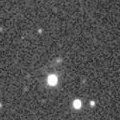
|
Observable at 17.5 mag in autumn. Because it is a distant comet, it will be observable at 17.5 mag in 2009 autumn again. Although it locates low this year, it will locate high and observable in good condition in 2009.
Date(TT) R.A. (2000) Decl. Delta r Elong. m1 Best Time(A, h)
Aug. 30 21 10.52 -17 33.2 2.932 3.886 157 17.4 22:34 (180, 73)
Sept. 6 21 6.86 -17 35.1 2.974 3.881 150 17.5 22:03 (180, 73)
|

|
Not recovered yet. But now it should be brightening up to 18 mag. It will reach up to 16 mag in October and November, and will be observable in good condition. It keeps observable in the morning sky until January when it will be fainter than 18 mag.
Date(TT) R.A. (2000) Decl. Delta r Elong. m1 Best Time(A, h)
Aug. 30 5 26.52 19 59.0 1.242 1.379 74 17.9 4:57 (211, 29)
Sept. 6 5 58.72 19 14.1 1.162 1.312 74 17.5 4:48 (215, 28)
|

|
Peculiar asteroid moving along a cometary orbit with a period of 40 years. It will be observable at 17.5 mag in good condition from August to September. It has already passed the perihelion in May.
Date(TT) R.A. (2000) Decl. Delta r Elong. m1 Best Time(A, h)
Aug. 30 22 11.47 7 17.6 2.150 3.129 162 17.6 23:34 (180, 48)
Sept. 6 22 6.46 7 40.5 2.178 3.146 160 17.7 23:02 (180, 47)
|

|
It reached up to 16 mag last winter. Now it is fading, but it will be observable at 17.5 mag in good condition from autumn to winter.
Date(TT) R.A. (2000) Decl. Delta r Elong. m1 Best Time(A, h)
Aug. 30 5 3.16 13 50.0 5.564 5.496 80 17.6 4:57 (208, 36)
Sept. 6 5 4.78 14 14.3 5.485 5.528 87 17.6 4:48 (203, 38)
|
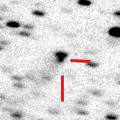
|
It was observed at 16.5-17 mag in 2006 and 2007. Because it is a very distant comet, it is observable at 17 mag still in 2008 in good condition.
Date(TT) R.A. (2000) Decl. Delta r Elong. m1 Best Time(A, h)
Aug. 30 17 39.53 42 28.9 6.340 6.517 95 17.7 19:03 (180, 13)
Sept. 6 17 35.86 41 51.6 6.419 6.539 92 17.7 19:08 (173, 13)
|

|
It keeps 17.5-18 mag for a long time until early summer in 2009. It becomes low in December, but it is observable in good condition except for that time.
Date(TT) R.A. (2000) Decl. Delta r Elong. m1 Best Time(A, h)
Aug. 30 18 29.25 47 52.7 2.838 3.199 101 17.8 19:52 (180, 7)
Sept. 6 18 12.51 45 38.0 2.874 3.173 97 17.8 19:08 (180, 10)
|
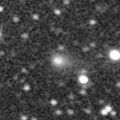
|
It was bright as 12.7 mag on May 12 (Juan Jose Gonzalez), and strongly condensed. However, it has been getting diffuse and fading rapidly after that. Now it is 18.2 mag (Aug. 3, L. Buzzi, F. Luppi). A temporary outburst has ended. It keeps observable in good condition until autumn. But it is moving southwards gradually, and the altitude will be getting somewhat lower in the Northern Hemisphere. It must be already too faint to see visually.
Date(TT) R.A. (2000) Decl. Delta r Elong. m1 Best Time(A, h)
Aug. 30 16 50.02 -22 5.5 2.277 2.600 96 18.1 19:03 (137, 73)
Sept. 6 16 57.54 -22 39.5 2.379 2.615 91 18.4 19:08 (123, 70)
|
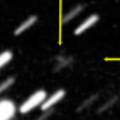
|
It was predicted to be so bright as 14 mag now. But actually, it is extremely faint as 19.5 mag (Aug. 4, Gustavo Muler). Although it locates in good condition, it will be hard to observe.
Date(TT) R.A. (2000) Decl. Delta r Elong. m1 Best Time(A, h)
Aug. 30 22 10.32 16 16.6 1.615 2.561 154 20.0 23:33 (180, 39)
Sept. 6 22 7.11 15 50.4 1.664 2.609 154 20.2 23:03 (180, 39)
|

|
It was observed at 16-17 mag at the discovery in 1999. It is predicted to be already 18 mag. But actually, it was not detected, fainter than 22.5 mag, in 2006 September (Carl Hergenrother). So it must be now fainter than at the discovery by 3-4 mag.
Date(TT) R.A. (2000) Decl. Delta r Elong. m1 Best Time(A, h)
Aug. 30 0 11.76 5 8.1 3.197 4.115 151 21.1 1:39 (180, 50)
Sept. 6 0 8.44 4 51.3 3.137 4.097 159 21.0 1:08 (180, 50)
|
|
![]()
 C/2005 L3 ( McNaught )
C/2005 L3 ( McNaught ) 199P/2008 G2 ( Shoemaker 4 )
199P/2008 G2 ( Shoemaker 4 ) 85P/Boethin
85P/Boethin 7P/Pons-Winnecke
7P/Pons-Winnecke 68P/Klemola
68P/Klemola 47P/Ashbrook-Jackson
47P/Ashbrook-Jackson C/2007 U1 ( LINEAR )
C/2007 U1 ( LINEAR ) 51P/Harrington
51P/Harrington 144P/Kushida
144P/Kushida 67P/Churyumov-Gerasimenko
67P/Churyumov-Gerasimenko 61P/Shajn-Schaldach
61P/Shajn-Schaldach C/2008 J6 ( Hill )
C/2008 J6 ( Hill ) 116P/Wild 4
116P/Wild 4 201P/2008 Q4 ( LONEOS )
201P/2008 Q4 ( LONEOS ) 44P/Reinmuth 2
44P/Reinmuth 2 P/2008 L2 ( Hill )
P/2008 L2 ( Hill ) C/2006 S3 ( LONEOS )
C/2006 S3 ( LONEOS ) P/2006 F1 ( Kowalski )
P/2006 F1 ( Kowalski ) 59P/Kearns-Kwee
59P/Kearns-Kwee P/2008 Q2 ( Ory )
P/2008 Q2 ( Ory ) P/2008 O2 ( McNaught )
P/2008 O2 ( McNaught ) P/2001 J1 ( NEAT )
P/2001 J1 ( NEAT ) 2008 JS14
2008 JS14 C/2006 K1 ( McNaught )
C/2006 K1 ( McNaught ) C/2005 S4 ( McNaught )
C/2005 S4 ( McNaught ) C/2008 Q1 ( Maticic )
C/2008 Q1 ( Maticic ) P/2008 J2 ( Beshore )
P/2008 J2 ( Beshore ) C/2007 K3 ( Siding Spring )
C/2007 K3 ( Siding Spring ) P/1999 WJ7 ( Korlevic )
P/1999 WJ7 ( Korlevic )![]()

































